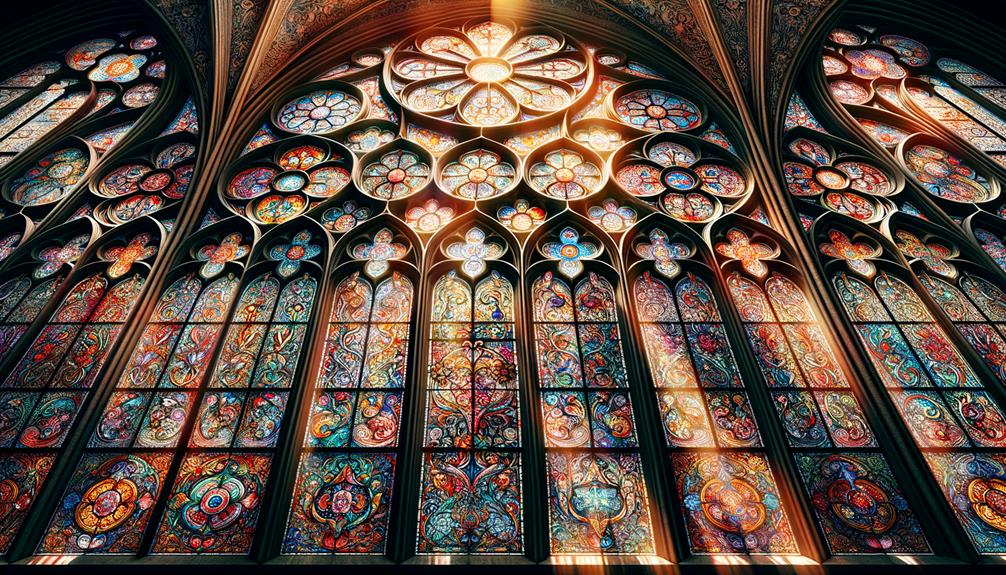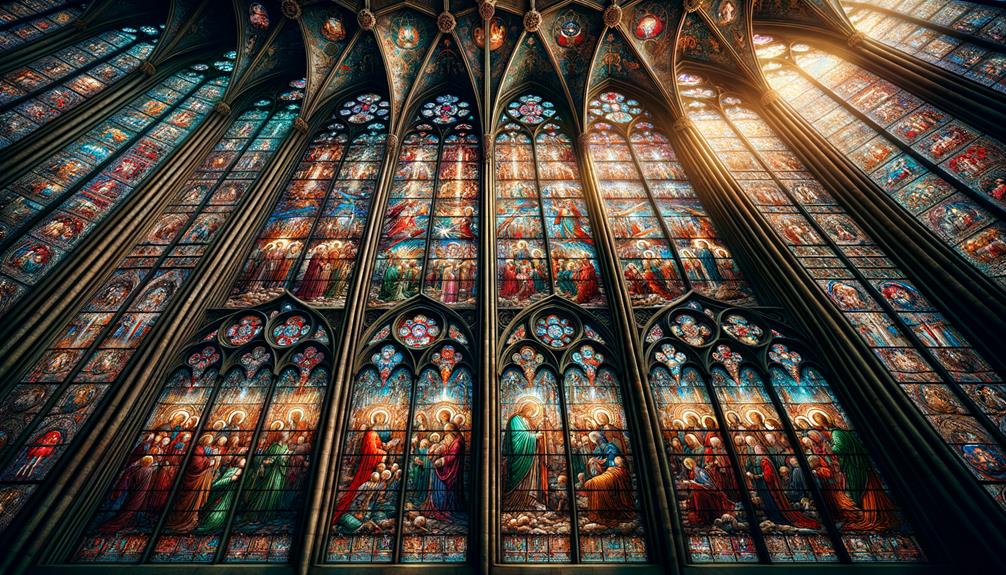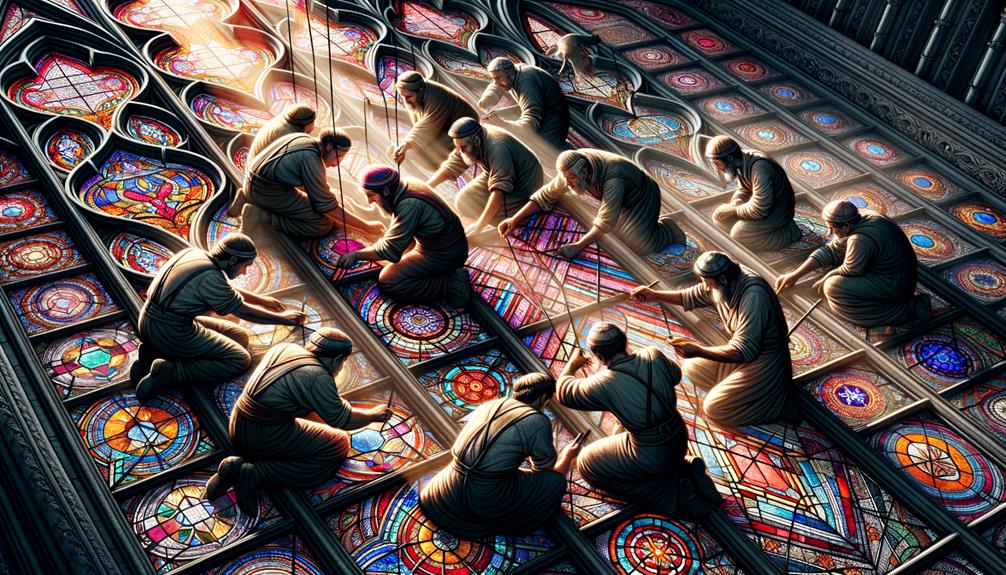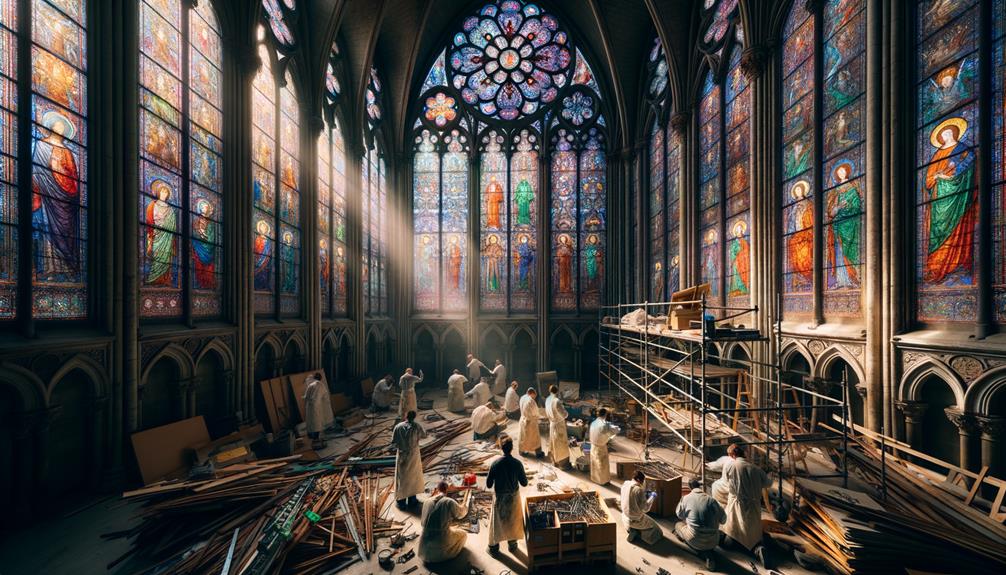You might not know that the stained glass windows of León Cathedral are often referred to as the 'Sistine Chapel of stained glass.' When I first stepped inside, the sunlight streaming through those ancient, vibrant panes felt like stepping into a different time. Each window tells a story, blending biblical narratives with medieval daily life, all crafted with precision that's almost surreal. The colors are so vivid; it's hard to believe they were created centuries ago. Yet, there's one aspect of these windows that often goes unnoticed, and it's this hidden detail that truly brings them to life.
Historical Background
As I stepped into León Cathedral, the intricate stained glass windows transported me to the 14th, 15th, and 16th centuries, where skilled artisans meticulously crafted scenes of nature and the supernatural. These windows, dazzling in their vivid colors and complex designs, were the handiwork of dedicated glass smiths and blacksmiths who joined glass panels with molten lead, creating scenes that ranged from historical and biblical to secular, reflecting the popular devotions of León and the Camino de Santiago.
Walking through the cathedral, I marveled at the 31 windows within the three roses and the 75 windows arranged in trefoil around the nave, transept, and apse. Each window told a story, offering a glimpse into the past. From scenes of saints and angels to depictions of everyday medieval life, the iconography was a tribute to the era's artistry and faith.
The extensive restoration efforts, spanning from the 15th to 19th centuries, have guaranteed that these stained glass windows remain a treasure for generations to admire. Their preservation speaks to the historical significance and enduring beauty of León Cathedral's stained glass, a testament to human creativity and devotion.
Architectural Significance

Walking through León Cathedral, I couldn't help but marvel at how its architectural grandeur is accentuated by the breathtaking stained glass windows that illuminate the sacred space. The cathedral, a masterpiece of French Gothic style, is a brilliant fusion of light and stone, where the stained glass plays a pivotal role. These windows, crafted by skilled glass artisans and metalworkers, are a testament to the meticulous artistry of the 14th to 16th centuries.
| Feature | Quantity | Locations |
|---|---|---|
| Large Rose Windows | 3 | West, North, South |
| Nave Windows | 10 | Along the Naves |
| Trefoil Windows | 75 | Around the Nave, Transept, and Apse |
The interplay of light through over 130 windows, including three grand rose windows, creates an otherworldly atmosphere that embodies the essence of French Gothic architecture. Each window, meticulously joined with molten lead and painted to enhance visual effects, tells a story, blending historical, biblical, and secular themes.
The extensive restoration efforts from the 15th to 19th centuries have ensured that these stained glass masterpieces continue to inspire visitors. The architectural significance of León Cathedral lies not just in its towering spires and intricate stonework but in how the stained glass transforms the space into a sanctuary of light and color.
Iconography and Themes

As I stood before the radiant stained glass windows of León Cathedral, I was struck by the intricate biblical and historical scenes, each pane a testament to the region's deep-seated devotions. The vivid depiction of St. James arriving in Galicia and the pilgrims in Compostela resonated with the spiritual journeys of countless believers. These windows masterfully weave together themes of nature and the supernatural, creating a captivating visual narrative that bridges the earthly and the divine.
Biblical and Historical Scenes
As I walked through León Cathedral, I was struck by the vivid biblical and historical scenes portrayed in the stunning stained glass windows. Each pane tells a story that spans centuries of faith and tradition, capturing the essence of religious devotion and cultural heritage along the Camino de Santiago.
The intricate details and rich colors of the stained-glass windows left me in awe. Three key scenes stood out:
- St. James arriving in Galicia: This window depicts the revered apostle's arrival, a pivotal moment for pilgrims.
- Pilgrims in Compostela: A portrayal of the spiritual journey of the faithful, reflecting the pilgrimage's significance.
- Historical events: Various panels showcase notable moments in both religious and secular history, blending the sacred with the everyday.
The higher windows, dating from the 14th to 16th centuries, beautifully contrast with the lower series, which were meticulously restored between 1895 and 1901. The craftsmanship of the glass smiths and blacksmiths is evident in every pane, highlighting a harmonious blend of the supernatural and natural world. Each window in León Cathedral is not just art but a timeless story told in light and color.
Popular Devotions Depicted
Standing before the radiant windows, I marveled at how the stained glass not only depicted biblical and historical scenes but also vividly captured the fervent popular devotions of Leon and the Camino de Santiago pilgrimage. Each pane seemed to tell its own story, drawing me into a world where faith and art intertwined seamlessly. One window vividly illustrated St. James arriving in Galicia, his figure radiating a divine presence that must have inspired countless pilgrims heading towards Santiago de Compostela.
The windows did more than just portray religious figures; they celebrated the very essence of the pilgrimage. I saw images of weary travelers finally reaching Compostela, their faces etched with relief and spiritual fulfillment. This cathedral is a testament to the devotion that has fueled the Camino for centuries. The windows, dating back to the 14th through 16th centuries, showcase a blend of artistic styles, each pane a piece of a larger, mesmerizing mosaic.
Thanks to extensive restoration work in the 19th and 20th centuries, these windows have retained their splendor, allowing modern-day visitors like me to connect with the age-old traditions and devotions that have shaped Leon and the Camino de Santiago.
Pilgrimage and Saint James
Gazing at the stained glass windows in León Cathedral, I was struck by how the iconography of Saint James and pilgrimage themes brought the ancient walls to life, making the spiritual journey feel tangible. The vivid scenes of St. James arriving in Galicia and pilgrims in Compostela capture the essence of the Camino de Santiago. Each pane weaves a narrative that seamlessly blends the natural and the supernatural, drawing me into the heart of the pilgrimage.
The windows not only illustrate biblical and historical motifs but also reflect the region's secular and popular devotions. Three aspects caught my attention:
Saint James' Arrival: The dynamic colors and intricate details of St. James landing in Galicia symbolize hope and divine guidance.
Pilgrims' Journey: Scenes of pilgrims trekking towards Compostela show their hardships and triumphs, embodying the spirit of the Camino.
Nature and the Divine: The integration of natural elements with celestial figures creates a captivating visual narrative that speaks to the spiritual and physical journey of the pilgrims.
The intricate iconography and themes in these windows enrich León Cathedral's cultural significance, making it a must-visit for both pilgrims and art enthusiasts.
Construction Techniques

Walking through León Cathedral, I was struck by the stunning stained glass windows, where skilled medieval artists meticulously crafted intricate designs directly onto the glass using molten lead to join the panels. As light streamed through, the colors came alive, transforming the space into a vibrant kaleidoscope.
Molten Lead Joins Panels
The artisans at León Cathedral meticulously join the stained glass panels with molten lead, transforming individual fragments into breathtaking works of art. As I walked through the sacred halls, I couldn't help but marvel at the large rose window, where each piece of glass is a testament to skilled craftsmanship. The process is fascinating:
- Precise Placement: Craftsmen carefully position each piece of glass in its designated spot, ensuring a perfect alignment of colors and shapes.
- Molten Lead Bonding: They apply molten lead to join the panels, creating a seamless connection that holds the entire window together.
- Structural Strength: This technique not only bonds the glass but also reinforces the window, allowing it to withstand the test of time.
Observing these techniques up close, I realized the immense dedication and precision involved. The interplay of light through the stained glass creates a kaleidoscope of colors that is nothing short of mesmerizing. This age-old method, rooted in tradition yet timeless in its beauty, ensures that the stained glass of León Cathedral remains a living canvas, continuously captivating visitors. The large rose window, in particular, stands as a vibrant masterpiece, symbolizing freedom and artistic expression.
Direct Glass Painting
Direct glass painting at León Cathedral is an art form that requires meticulous skill and attention to detail. Artists apply intricate designs directly onto the glass, creating vibrant and detailed scenes that come alive with the play of light. As I walked through the cathedral, I was captivated by the sheer artistry and dedication that went into each pane.
The artists, armed with delicate brushes, paint directly on fixed glass, transforming it into a canvas that tells stories of faith and history. Each stained glass panel is a testament to the collaboration between glass smiths and blacksmiths. It's fascinating to think about how these skilled craftsmen worked together, joining the painted glass panels with molten lead.
The lead not only provided structural stability but also framed each piece of art, enhancing its visual impact. León Cathedral's stained glass windows are more than just decorative elements; they are a window into the past, meticulously preserved through extensive restoration work in the 19th century. As I stood there, bathed in the colorful glow filtering through the windows, I felt a profound connection to the artisans who, centuries ago, brought these masterpieces to life.
Optical Light Effects
Exploring the construction techniques behind León Cathedral's stained glass windows, I was struck by how optical light effects were meticulously engineered to transform sunlight into a kaleidoscope of colors. Each glass panel, joined by molten lead, was not just a piece of art but a scientific marvel. Painters directly painted on the fixed glass to amplify these effects, using pigments that interacted with light to create an illusion of movement and depth.
The cathedral's designers incorporated optical science to manipulate light in ways that would heighten the drama of the sacred space. Three key techniques stood out:
Lead tracery played a crucial role, as the molten lead joining the glass panels influenced how light passed through, creating sharp contrasts and outlines. Specific pigments were used to refract light differently, enhancing the vibrancy of each scene depicted in the glass. In the 19th century, extensive restoration work was carried out to preserve these optical effects, ensuring that the windows continued to dazzle future generations.
Walking through León Cathedral, I felt a profound sense of freedom, as if the windows themselves were alive, guiding light into the sacred space.
Restoration Efforts

Walking through the grand halls of León Cathedral, I marvelled at the meticulous restoration efforts dedicated to preserving its magnificent stained glass windows. Each pane of glass, a fragment of history, is carefully attended to by skilled artisans who understand the importance of maintaining the cathedral's legacy. The conservation work is about more than just aesthetics; it's about protecting centuries-old craftsmanship from damage over time.
As I watched the restoration experts delicately remove a stained glass panel, I was struck by their precision. They work closely with historians and scientists to ensure every repair stays true to the original design. The goal is to prevent the deterioration of these intricate artworks while retaining their historical integrity. This balance is crucial for the long-term sustainability of the stained glass windows.
The restoration process involves not only repairing damage but also protecting the windows from future harm. Innovative techniques and materials are used to ensure the vibrant colors and detailed scenes within each window continue to inspire awe for generations to come. These dedicated efforts guarantee that León Cathedral's stained glass windows remain a breathtaking testimony to human creativity and devotion.
Visitor Experience

As you step into León Cathedral, the kaleidoscope of colors cast by its magnificent stained glass windows is simply breathtaking. These 13th-century masterpieces are more than just decorations – they're vivid biblical narratives crafted by local artisans. Here's what you can expect during your visit:
- Visual Splendor: The stained glass windows illuminate the cathedral's interior with a mesmerizing play of colors and patterns. As natural light streams through, the atmosphere becomes even more sacred and awe-inspiring.
- Historic Craftsmanship: The rosette window on the western facade, symbolizing the Last Judgment, is a standout feature. Its intricate tracery and craftsmanship are a testament to the skill of the artisans who created these masterpieces.
- Cultural Significance: Beyond their visual appeal, the stained glass windows are cultural and religious symbols that attract visitors from around the globe. They offer a glimpse into León's spiritual and cultural heritage.
As you wander through the cathedral, you can't help but feel a deep connection to the past, making the León Cathedral visit an unforgettable experience.



